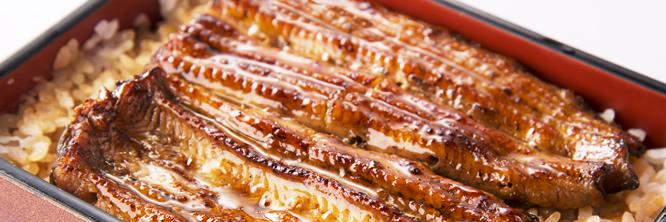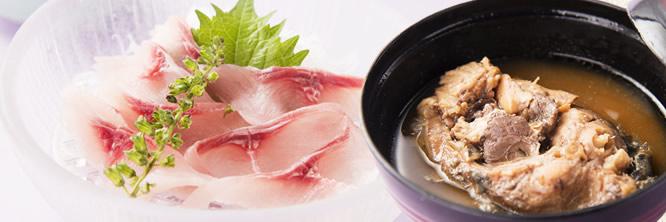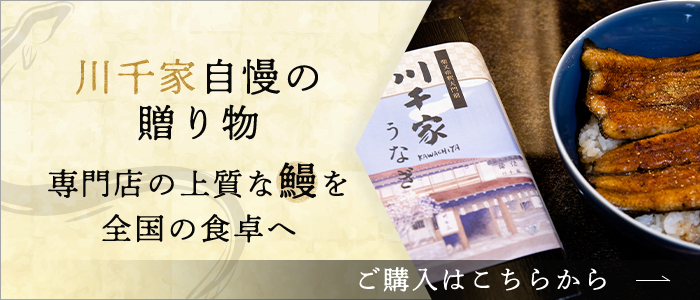- HOME
- TRIVIA E
TRIVIA
The Trivia of UNAGI

Waiting Time for Unagi Dishe
Usually it is said to cook KABAYAKI (grilled eel) that it takes 5 minutes for preparation, 20 minutes for grill, 20 minutes for steaming and 5 minutes for finished-grill. KAWACHIYA is trying serve KABAYAKI at the best condition without waiting for a long time. However please note that it will take approximately 30 ~ 40 minutes to serve KABAYAKI at busy hours. Thank you in advance for your patience.
The Origin of the Name of UNAGI?
According to one theory, the name of UNAGI comes from “MUNA-GI” which means “Yellow chest” because the chest of wild UNAGI is yellow-ish whereas farm-raised UNAGI’s chest is white. We, KAWACHIYA, will get wild UNAGI if we have a chance. Though it is more expensive than farm-raised one, you may have an opportunity to see the “yellow-chest” UNAGI here.
Nutrition Contained in UNAGI (Eel)
Eel is rich in unsaturated fatty acids especially DHA (Docosahexaenoic acid) and EPA (Eicosapentaenoic acid)and also contains large amount of Vitamin A and Vitamin B2).
1) Nutrient Dictionary, Takako Norioka, ISBN978-4-405-09198-6
2) Science of Eel, Katsumi Tsukamoto, ISBN978-4-254-48502-8
How to Grill UNAGI (Eel)
process. As the result, Kansai style KABAYAKI has more hard texture and spicy smell. KAWACHIYA serves Kanto style (soft texture) KABAYAKI for UNA-JU and Kansai style for HITSU-MABUSHI. Please try both styles of KABAYAKI in KAWACHIYA.
The Trivia of Carp

KOI
In Japan, carp has been an important food as a precious nutrition source and for ceremonies as well.
We have proudly served specialty carp dishes for years. For both every day and special day meal for your family, how about enjoy our specialty carp dishes?
鯉の料理法
KOI-ARAI (Sliced Raw Carp): Slice raw carp. Then wash with hot water after that cool with iced water to firm up. By this process, fat on the surface are removed and muddy smell disappears.
Vinegared miso (fermented soybean paste) goes well with KOI-ARAI.
KOI-KOKU (Carp Miso Soup): Our cook tells the secret that carp with scales should be used for KOI-KOKU. Scales of carp is to be soften when boiled so that you can eat even scales.
Nutrients in Carp
It has been said for a long time that carp is nutritious food. Today it is known that carp is rich in proteins, lipids, minerals and vitamins. Especially carp is relatively rich in vitamin B than other fish.
KOI-GOYOU (Carp Wholesaler)
TO-RYU-MON (Gateway to be a Dragon)
Even today, the custom remains in Japan that carp banners are displayed outside on Children’s day on 5th May to wish good health and growth of children.
Carp Dishes for Expectant Mothers
Interestingly, there is a poem describing how carp dish improved production of mother’s milk in the poem collection book of Edo era named YANAGI-DARU.
Food Safety Information
References:
Complete book of Edo-mae fish dishes, Kazunari Tomioka, Sou-shi-sya.
Dictionary of Food Ingredients, Shogakukan.
Picture Dictionary of Fish and Shellfish, Syu-fu-sya.
Ethnic encyclopedia of Foods, Kanichi Nomoto, Kashiwa-shobo Co., Ltd.
Dictionary of Nutrients, Takako Norioka, Shinsei Publishing Co., Ltd.

 03-3657-4151
03-3657-4151




